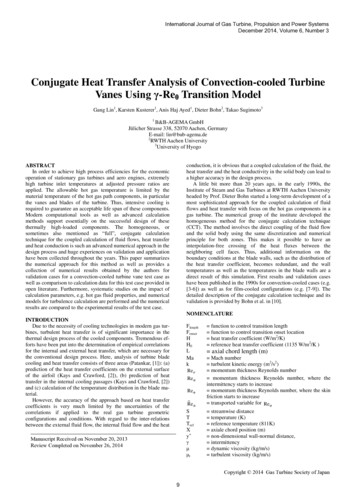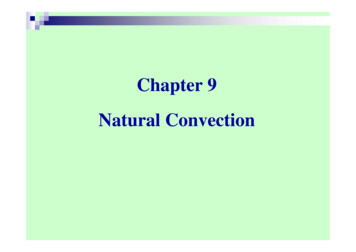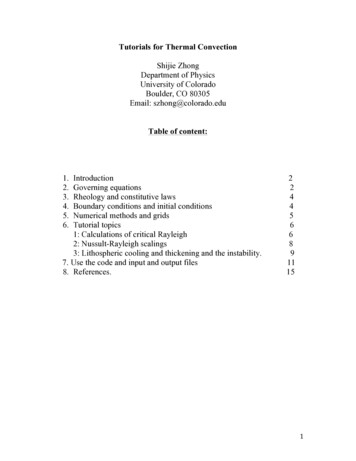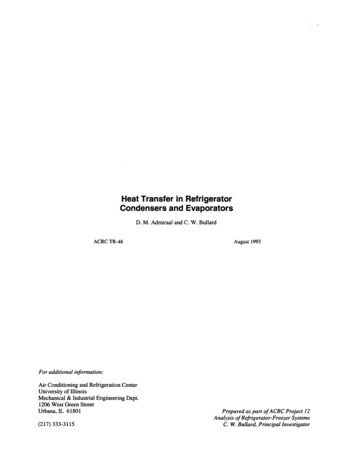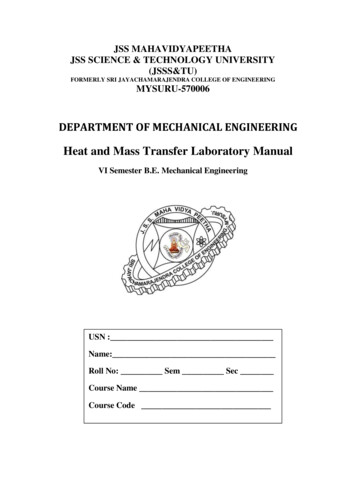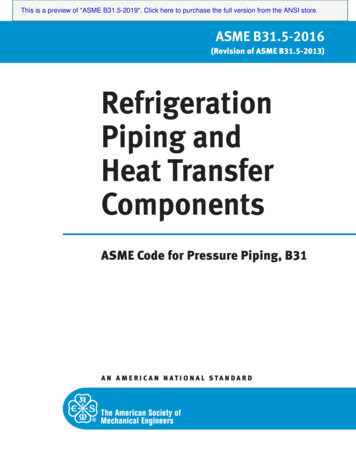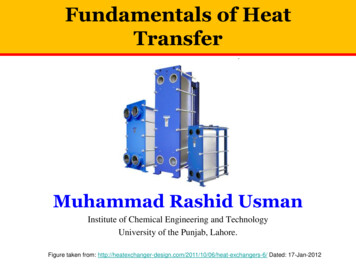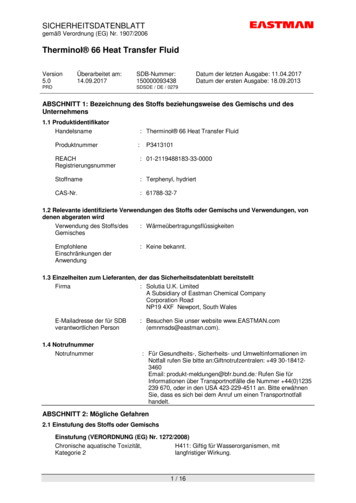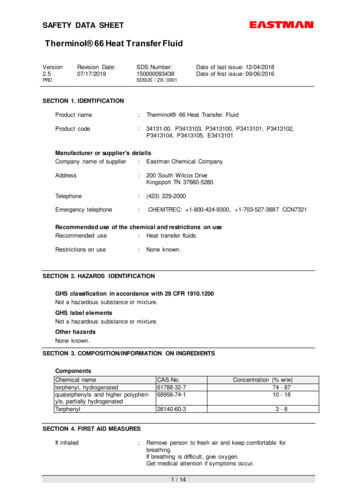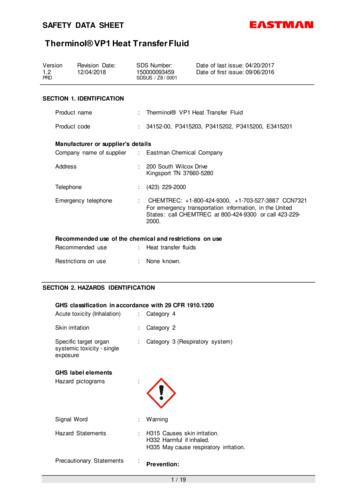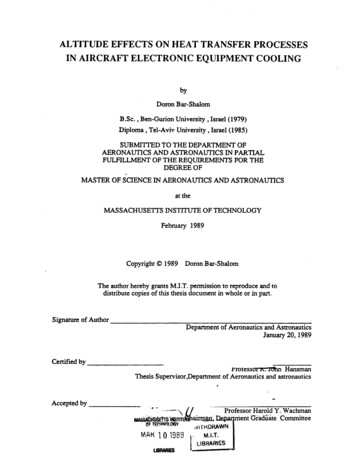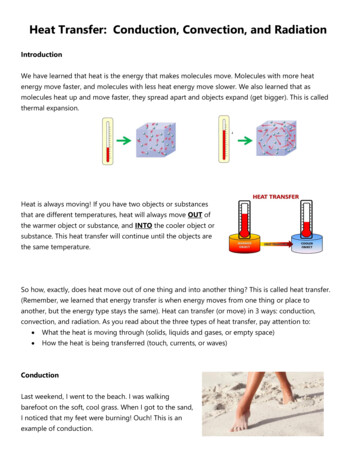
Transcription
Heat Transfer: Conduction, Convection, and RadiationIntroductionWe have learned that heat is the energy that makes molecules move. Molecules with more heatenergy move faster, and molecules with less heat energy move slower. We also learned that asmolecules heat up and move faster, they spread apart and objects expand (get bigger). This is calledthermal expansion.Heat is always moving! If you have two objects or substancesthat are different temperatures, heat will always move OUT ofthe warmer object or substance, and INTO the cooler object orsubstance. This heat transfer will continue until the objects arethe same temperature.So how, exactly, does heat move out of one thing and into another thing? This is called heat transfer.(Remember, we learned that energy transfer is when energy moves from one thing or place toanother, but the energy type stays the same). Heat can transfer (or move) in 3 ways: conduction,convection, and radiation. As you read about the three types of heat transfer, pay attention to: What the heat is moving through (solids, liquids and gases, or empty space) How the heat is being transferred (touch, currents, or waves)ConductionLast weekend, I went to the beach. I was walkingbarefoot on the soft, cool grass. When I got to the sand,I noticed that my feet were burning! Ouch! This is anexample of conduction.
Conduction is how heat transfers through direct contact with objectsthat are touching. Any time that two objects or substances touch, thehotter object passes heat to the cooler object. (That hot sand passedthe heat energy right into my poor feet!)Think of a row of dominoes that are all lined up. When you push the first domino, it bumps into thesecond one, which bumps into the third one all the way down the line. Heat conduction is like thedominoes. Imagine that you place one end of a metal pole into a fire. The molecules on the fire endwill get hot. Each hot molecule will pass the heat along to the molecule next to it, which will pass theheat along to the next molecule, and so on. Before you know it, the heat has traveled all the wayalong the metal pole until it reaches your hand.Some materials are better conductors than others. That’s because some materials are able to pass(conduct) heat more easily. Metals are great conductors. That’s why metal objects get hot so easily.Plastic and wood are poor conductors. They will still get hot, but it takes a lot longer for them to passthe heat from molecule to molecule.Likewise, solids are better conductors than liquids or gases. That’s because solids have molecules thatare very tightly packed together, so it’s much easier for the molecules to pass the heat along. Themolecules in liquids and gases are spread further apart, so they aren’t touching as much. It takeslonger for liquids and gases to conduct heat.There are many examples of heat conduction. Any time two object touch, heat conduction willhappen. Touching a hot iron is an example of conduction – the heat passes out of the iron and intoyour hand. So is holding an ice cube – the heat is conducted out of your hand, and into the ice cube(that’s why your hand feels cold). Cooking food on the stove is an example of conduction happeningtwice – the heat from the burner passes into the metal pan, and then the heat from the metal panpasses into the food, heating it up.
ConvectionConvection is how heat passes through fluids. A fluid is anything that has loosely moving moleculesthat can move easily from one place to another. Liquids and gases are fluids.One important property of fluids is that they rise when heated. That’s because the molecules spreadout and move apart when they get hot. The hot fluid becomes less dense and rises up. Cooler fluid isless dense and so it sinks down. This up-and-down motion creates what are called convectioncurrents. Convection currents are circular movements of heated fluids that help spread the heat.Here’s an example. Last night I heated up soup for dinner. Yum! At first, the soup was cold in the pan.The soup at the bottom of the pan was closest to the hot stove burner, right? So the soup at thebottom heated up first. As it heated, the molecules spread apart and became less dense. So theheated soup rose up to the top.As the hot soup rose up, the cooler soup at the top sank down to thebottom. When it was at the bottom, it was closest to the heat, so THATsoup got hot and rose up. As the soup continued heating, the hot souprose and the cold soup sank. If you were to look closely, you would see thesoup moving up and down in the pot. The up-and-down movement was aconvection current. The convection current helped spread the heat around,until all of the soup was heated up.Convection currents explain why the air is hotter at the top of a room and cooler at the bottom.Convection currents also explain why water is warm at the top of the ocean, but gets colder as youswim deeper.
One natural example of convection currents is wind. As the Sun shines down on an area of land, itheats the air above the ground. That warm air rises. As it rises, cooler air moves in to take the place atthe bottom. This moving cooler air creates wind! Wind happens all over Earth because Earth heatsunevenly. There are always colder parts and warmer parts. The wind blows from the cooler parts ofEarth to the warmer parts.Other examples of convection are: boiling a pot of water on the stove; using a hot radiator to warmthe air in a room; and using heated air to make a hot-air balloon rise up into the sky.RadiationSo we’ve learned that conduction moves heat easiest through solids, and convection moves heatthrough liquids and gases. So how does the heat from the Sun get to Earth? There are no moleculesin space! And how do you feel the heat from a campfire, even if you’re sitting several feet away?The answer is radiation. Radiation is how heat moves through places where there are no molecules.Radiation is actually a form of electromagnetic energy. Remember we learned that electromagneticenergy moves in waves? Well, radiation is heat moving in waves. Radiation does NOT need moleculesto pass the energy along.All objects radiate heat, but some radiate much more heat than others. The biggest source ofradiation is the Sun – it sends a HUGE amount of heat to Earth through electromagnetic waves. (Lastweekend, at the beach, I could definitely feel the wonderful heat radiation from the Sun. I guess that’swhy I got a sunburn. Oops! A little too much radiation!)
Light bulbs radiate heat. Try it! Hold your hand a few inches away from a light bulb. You can feel theheat, right? In fact, a good way to remember radiation is that it is how you can feel heat withouttouching it. Heat passes through the empty space until it reaches your hand. That’s radiation! A fire isanother example of radiation. Even YOU are an example. Your body gives off heat! (That’s why aclassroom gets warm when there are a lot of people sitting in it.)ReviewRemember – heat always passes from a warmer object to a cooler object until all objects are the sametemperature.Conduction is how heat travels between objects that are touching. Conduction travels fastest throughsolids, but liquids and gases can also conduct heat. Some materials, like metal, can conduct heat veryquickly, while other materials (like plastic or wood) conduct heat very slowly.Convection is how heat travels through fluids – liquids and gases. Hot fluids rise up, while cold fluidssink down. This up-and-down motion is called a convection current. Convection current spreads theheat in a circular, up-and-down pattern.Radiation is how heat travels through empty space. Radiation does NOT require molecules to travelthrough. Any time you can feel heat without touching it, you are experiencing radiation.
So how, exactly, does heat move out of one thing and into another thing? This is called heat transfer. (Remember, we learned that energy transfer is when energy moves from one thing or place to another, but the energy type stays the same). Heat can transfer (o
